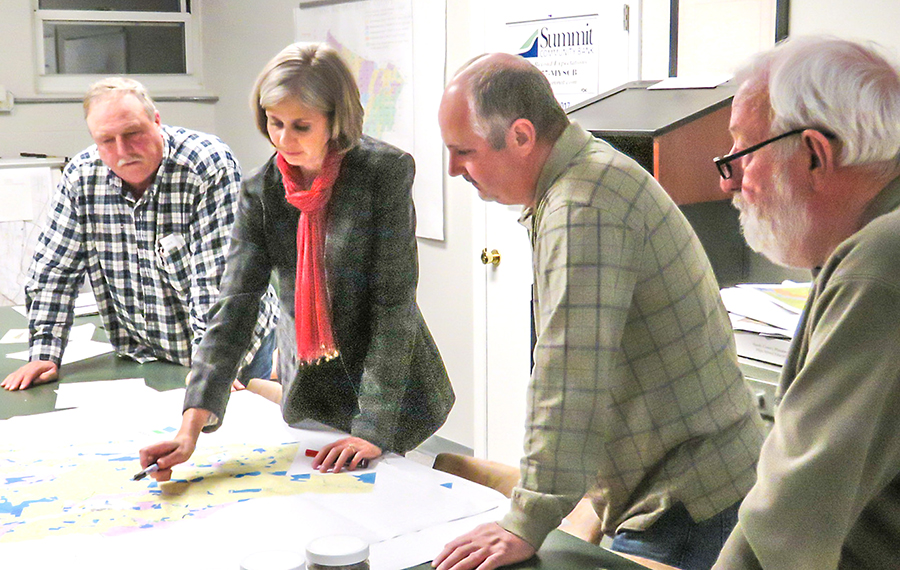By Lon Anderson
Moorefield Examiner
The March meeting of the Hardy County Planning Commission started off normally enough with a discussion of the morning’s County Commission meeting, approval of minutes, and discussions about the GIS Board and flood plains. It was only towards the end of the meeting that the bombshell dropped: Melissa Scott, Hardy County’s Planner for the last seven years, announced that she’s leaving her position to join a consulting firm.
The news seemed to stun members of the Planning Commission, with whom she has worked closely for her entire tenure in the County. Under her guidance, Hardy County has developed a statewide reputation as a leader in land use planning among the small, rural West Virginia counties. Because of her expertise, she also serves as the County’s Flood Plain manager and oversaw the creation of the County’s [private]GIS (Geographic Information Systems) Board to coordinate use and sharing of this critical information management tool.
“We have been so lucky to have her for seven years,” Lehman told the Examiner. “So lucky!”
Officially Scott’s last day will be March 17, although she committed to returning for the April Planning Commission meeting as well.
Asked about her departure, a state leader in land use planning, Jesse J. Richardson, Jr., the lead land use attorney in the Land Use and Sustainable Development Law Clinic at WVU, said it was “a great loss for the State of West Virginia and Hardy County. She is one of the lead planners in the state, and you really can’t replace Melissa.”
As a result of her announcement, the Planning Commission immediately took two actions to keep operations moving in her absence. The first was a resolution to authorize Commission President Lee Lehman and Vice President Greg Greenwalt to take the lead on formulation the FY 2021 budget. The second was a motion authorizing the Commission to move remaining salary funds into a consulting fees account. Both passed unanimously.
Prior to Scott’s announcement, the Commission had taken up several items of business. In her report on the County Commission meeting held earlier that day, Scott told the Planning Commissioners that she believes the County Commissioners will likely approve the By-laws for the new GIS Board, which have been pending before the County for three months, if the By-laws are changes to add a seat on the Board for the RDA (Rural Development Administration) and make the County Commissioner seat on the Board a voting one.
She noted that in the draft By-laws it was proposed that the Commissioner’s position be non-voting because the County Commissioners have final say on everything the Board does, thus that would give the County Commissioner two votes. The RDA, she noted, had not been included because it had been invited on numerous occasions to use the GIS system, but to date had not shown any interest.
Also concerning the GIS, Scott reported that Paul Lewis, County Emergency Services and 911 Director, will be picking up the additional costs from his budget for an upgraded GIS package for the County that will allow many users, and make the system far more accessible for those County offices needing to utilize it.
“So how about the 911 addresses?” asked Greenwalt, referring to the process of reviewing and correcting faulty address information in the GIS system that has been underway for months with Planning Commission staff assistance.
“We’re down to under 1,000 addresses to finalize, but finishing those will be a significant amount of work,” Scott reported, noting that some of those will require site visits.
“That’s a good thing,” Greenwalt responded. “There were a significant number of units not properly located.”
“A couple of times a year we get an influx of new addresses that have to be processed, especially after a flurry of spring building permits,” Scott added.
The County Commissioners, Scott reported, also discussed construction in the flood plains. She noted that FEMA (the Federal Emergency Management Agency) is, through state agencies, requiring a letter certifying that the construction in flood plains meets its standards. These standards, she explained, “are to ensure that buildings in the flood plain are not going to collapse and float down the river when flooding occurs. And we will have to follow those regulations for any construction in the flood plains.”
Scott told the Planning Commission that County Commission President Harold Michael repeatedly asked her why she could not sign off on building permits for construction in the Flood Plains. This, she said, will require the signature of a certified building inspector who understands the engineering, and that, as Flood Plain Manger, she does not have the expertise to sign such a certification. Doing so, she noted, could create a major liability for the County. This only applies for new construction and is only concerned with the foundation, she added.
“If we don’t have someone qualified going out (to the building site) and signing off, eventually something is going to happen,” she told the Planning Commissioners.
“This (policy) has been reviewed by the (WVU) Law Clinic and State and they’ve signed off on it,” noted Greenwalt. “You’re really protecting property owners with this and if we don’t do this, one of these days the County will face a big problem.”
“We’ve done our part to get this policy done,” Lehman noted.
“So what Harold is asking for is a letter stating this is required?” asked Greenwalt. “So what’s our next step?”
“We need to officially recommend adoption of this policy (for flood plain construction),” Scott replied.
“So moved!” said Greenwalt. And with that the Commission passed the motion with only Jay Fansler abstaining because he would later be voting on it as a County Commissioner.
“Really all of this is not normally a Planning Commission function,” Scott noted. “You guys just got lucky because I am also the Flood Plain Manager.”
“So we really don’t have a formal role,” Greenwalt said. “We’re just reviewing it and recommending its adoption.”
For the month of February, there were 16 building permits totaling $10,760,000, Scott reported. One was for a $10 million poultry complex and all of the others totaled $760,000, she explained.[/private]

